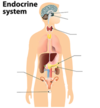Hormones Flashcards
Where is the hormone ADH made?
The pituitary gland
Where is the hormone adrenaline made?
The adrenal glands (on top of the kidneys)
Where is the hormone insulin made?
Pancreas (by beta cells)
Where is the hormone testosterone made?
The Testis
Where is the hormone progesterone made?
Ovaries
Where is the hormone oestrogen made?
Ovaries
Where is the hormone FSH made?
The pituitary gland
Where is the hormone LH made?
The pituitary gland
What does ADH stand for?
Antidiuretic Hormone
What does LH stand for?
Luteinising Hormone
What does FSH stand for?
Follicle Stimulating Hormone
Which is the target organ for the hormone ADH?
The kidneys
Which is the target organ for the hormone adrenaline?
Heart; Lungs; muscles
Which is the target organ for the hormone insulin?
Liver
Which is the target organ for the hormone testosterone?
Male reproductive organs
Which is the target organ for the hormone progesterone?
The uterus and mammary glands



